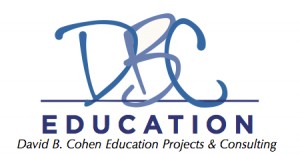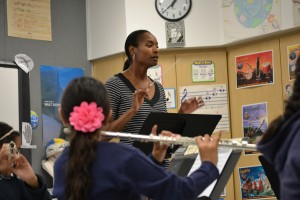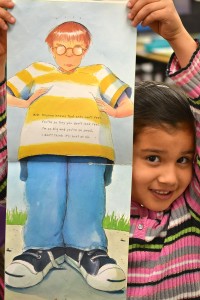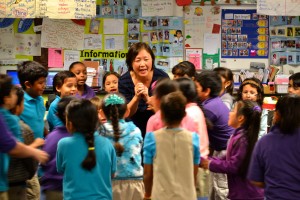First published in “Road Trips in Education” at EdWeek Teacher (5/23/15).
I’m sitting in Room 1 at Lincoln High School in San Jose, CA. It’s the Friday before Memorial Day weekend, and there are fewer than ten school days left for these students. I’m visiting math teacher Nancy Ureña Reid, who teaches Geometry and A.P. Computer Science. Ostensibly, I’m here gathering notes and observations for my upcoming book surveying California public schools and teachers, but my mind is wandering quite a bit. I should be more focused on the students who are working on a school design project, putting geometric and other mathematical concepts to use while envisioning and representing a modernized campus. I should be more attentive to the ways that Nancy circulates around the room, the questions she asks that force students to recognize their assumptions or reconsider certain aspects of their designs. Instead, my thoughts are more personal: it’s starting to sink in that the central element of my work this year is coming to an end.
My goal throughout the 2014-15 school year has been to find and describe excellent teaching in public schools throughout California. I’ve visited elementary, middle, and high schools from September to May. The smallest schools had barely 100 students, while the largest enrolled around 3,000. The furthest points in my journeys – Arcata and El Centro – were 877 miles apart. I’ve been to two schools named Luther Burbank, and two Abraham Lincoln High Schools. The Lincoln I’m visiting today represents my 63rd and final school visit.
This blog, “Road Trips in Education,” derives its name from that undertaking, and while I’ve written about several of those experiences in this space, I’ve also maintained broader focus. The conclusion of my road trips will not mean the conclusion of this blog, as I’ll continue to draw upon my learning from the year. For today though, looking back, I wanted to share the most common reactions and questions I’ve heard in conversations on the road.
“Thank you for doing this!”
Truthfully, gratitude was probably the second most common reaction, the most common being some kind of polite, general approval: That’s great! But the spontaneous thanks turned out to be fairly common and no longer surprised me after the first several weeks.
The most likely people to say “thank you” were the colleagues of the teacher I was visiting. My hosts often said, “Thanks for visiting,” and appreciated the opportunity to share their classrooms and their work. But the teachers I visited were usually people I knew already, or at least had corresponded with for a while, and so they were long past any initial reaction to the project itself. But then, at some point during the day, I would meet a teacher down the hall, a secretary, campus security guard, or parent volunteer, and their eyes would light up when they heard that a stranger was visiting the school to write something positive. For some people, I think it was an expression of relief, reaction to the idea that their school’s good work might receive some recognition. For others, it was explicitly a thanks for seeking the positives in public education generally. In either case, the gratitude came with an implication of underlying fatigue with the constant negativity that dominates the broadest public discourse about schooling.
“Good things about public education? That’ll be a short book.”
There are cynics out there, and some are not shy about sharing their cynicism. They may come by their doubts honestly, through years of work in public education. The system itself is often overstressed, under-resourced, impersonal and bureaucratic, leaving teachers close to burning out. Some of the cynics, especially outside of schools, acquired their doubt long ago and express it more as reflex than thought; they view schools as another unresponsive state or municipal bureaucracy. They tend to have little actual contact with public schools, and outdated understandings of teaching and learning (which isn’t to say schools have given up all their outdated practices).
What different types of cynics have in common is a tendency to generalize negatives while seeing positives as the outliers. The argument that I’ll put forth in my book is that the positives are easy to find if you look for them, an approach that needs to be more common.
“What’s the best thing you’ve seen?”
This question usually comes from my teaching peers, but again, I think there are different kinds of thinking behind the question. Some people just love knowing more about schools and teaching, and they relish hearing about the best that’s out there, the same way that your foodie friends will ask about the best restaurant you visited on a recent trip. Others are eager to experiment, and always on the lookout for something they can try to adapt or borrow to improve their own practices.
It’s a difficult question to answer, asked so broadly. Some teachers are inspirational because they clearly love each and every student who comes through the door, and they live and breathe their work, summoning the energy and skill to provide for the academic and personal needs of the children growing in their care this year. Other teachers inspire through their incredible grasp of subject matter, and in their presence, you can’t help but see the world through their eyes – as scholars, scientists, artists. Some work their magic by fulfilling a vision of student-centered classrooms that hum with inquiry and creativity, and others have a gift for helping students with the metacognitive aspects of learning; their students understand the how and why of learning, and they exude confidence about the future. I’ve seen it all, but I can’t say what’s best.
“What’s the secret, the key to improving schools?”
Perhaps this is a variation of the question above, with a broader focus. This question usually comes from someone other than an educator, and they want to believe that there’s one main obstacle, one insight that could be analyzed, shared, and used to bring about positive change on a wide scale. It’s flattering that they think I’d know.
I’m tempted to say, “I have the answer, but you’ll have to buy my book.” The truth is, I don’t have the answer, but I think the best answers come from letting people figure it out for themselves. I’m not suggesting that school improvement starts from scratch or happens in a vacuum: “figuring it out” involves serious analysis and reflection, gathering a variety of data and opinions, considering available research, and studying relevant models. If there is a key to better schools, it doesn’t involve simple ideas like choice, or firing bad teachers, and it certainly doesn’t come in a box or a download or a subscription. And when we do talk about improving public education, it must be for all schools, and all children. The underlying inequities impeding progress in many schools reflect the same inequities we’ve never been willing to confront as a nation.
I’m still processing the experience, and writing about it will surely help me figure out more of what I actually learned this year. So, it may be the end of the road, but the journey continues.




